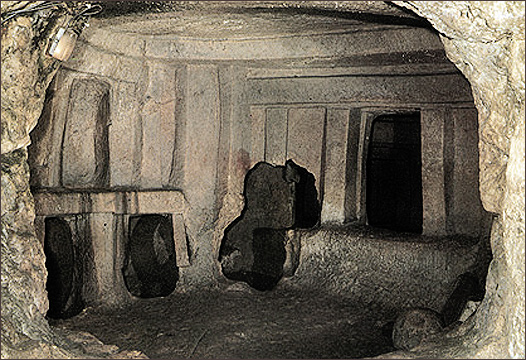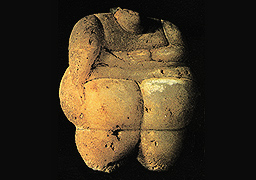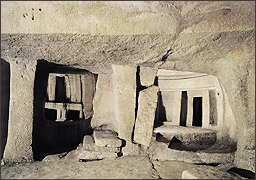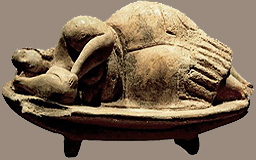 |
 |
SAFLIENI – c. 3300-3000 BC - THE HYPOGEUM |
Page 3/6 |
Like the
Mgarr phase the Saflieni period was another short phase (c. 3300-3000 BC), its name is taken from the place-name of the Hypogeum, a structure hewn out of rock, three storeys high and was used for two purposes - burial (several thousand individuals, along with personal ornaments and pottery items have been found) and also as a place of worship. The Hypogeum's large architectural hall with trilithons and blind niches closely resemble those of the temples.
Three storeys high the Hypogeum was discovered by accident in 1902 by building workers engaged on a new housing development broke through the roof. The workers tried to hide the temple at first, but eventually it was found. The study of the structure was first carried out by Father Manuel Magri of the Society of Jesus, who directed the excavations on behalf of the Museums Committee. He died in 1907, before the report was published. Following Magri's death, excavation resumed under Sir Temi Zammit.
The Hypogeum is the only prehistoric underground temple in the world. To commemorate the acceptance by UNESCO of the Hypogeum structure in the World Heritage Site list, it was depicted on a 2 cents 5 mils stamp issued in the Maltese Islands.

| First Level |
| The first level is very similar to tombs found in Xemxija in Malta. Some rooms are natural caves which were later artificially extended. From evidence, one can say that this is the oldest level. The second level was only opened when the original builders found that this level was no longer adequate. This level is only ten metres below the street level. |
| Second Level |
| The level shows magnificent skill in stonework. One can see several important rooms, such as the Main Room, the Holy of Holies, and the Oracle Room. |
| The Main Chamber |
| This chamber is roughly circular and carved out from rock. A number of trilithon entrances are represented, some blind, and others leading to another chamber. Most of the wall surface has received a red wash of ochre. It was from this room that the statuettes of the sleeping lady were recovered. Nowadays these figurines are held in the Museum of Archaeology, in Valletta, Malta. |
| The Oracle Room |
| The Oracle Room is roughly rectangular and one of the smallest side chambers has the peculiarity of producing a powerful acoustic resonance from any vocalization made inside it. This room has an elaborately painted ceiling, consisting of spirals in red ochre with circular blobs. |
| The Decorated Room |
| Out of the Oracle's Room, through the hammer dressed chamber, on the right is another spacious hall, circular, with inward slanting smooth walls, richly decorated in a geometrical pattern. On the right side wall the entrance is a petrosomatoglyph of a human hand carved into the rock (Agius). |
| The Snake Pit |
| The second level contains a 2 metres deep pit which could have been used for either keeping snakes or collecting alms. |
| Holy of Holies |
| The focal point of this room is a porthole within a trilithon, which is in turn framed within a larger trilithon and yet another large trilithon. |
| Third Level |
| The lower storey contained no bones or offerings, only water. It strongly suggests storage, maybe of grain. |
The cult of these ancestors seems to be linked to that of 'Mother Earth'. It is possible that they believed certain religious rites performed below ground symbolized a temporary return to the womb of 'Mother Earth' from which all life derived.
The 'Sleeping Lady' is a representation of a woman with abudant forms lying on her right side on a couch. It possibly suggests the practice of the rite of incubation.
Below is shown a headless alabaster statuette of an extremely fat human figure whose sex is not indicated.
Headless Alabaster Statuette
→
Bradshaw Foundation














